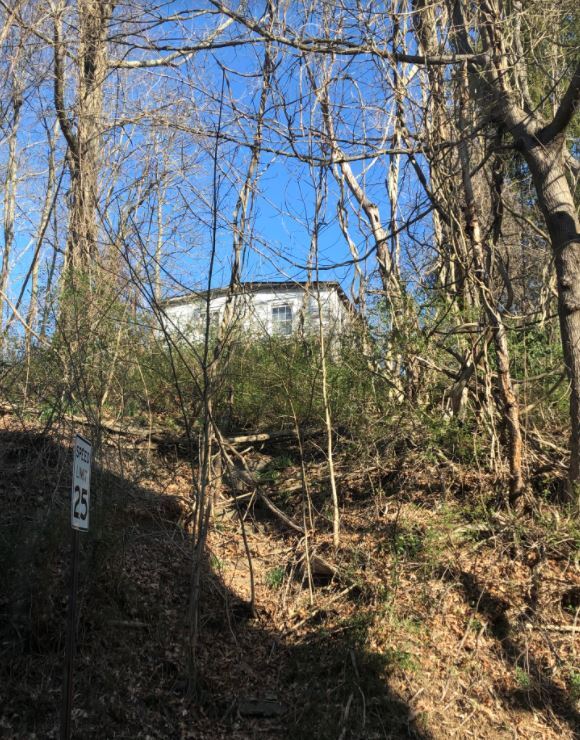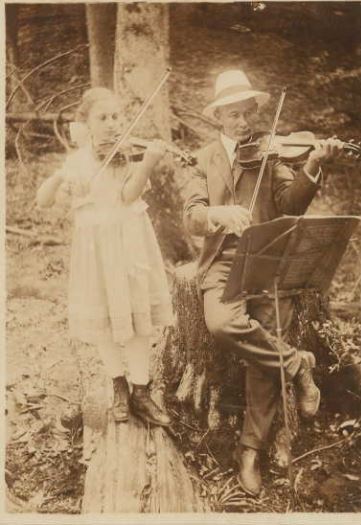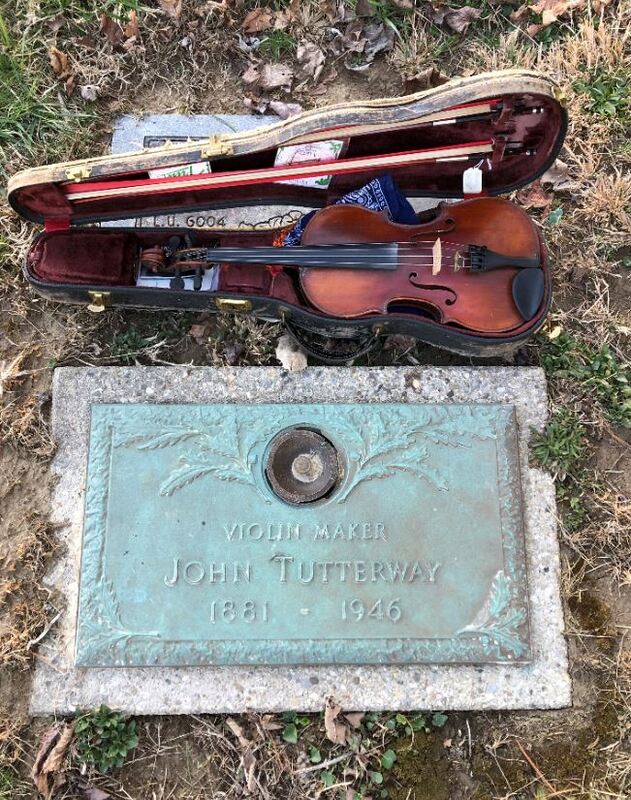John Tutterway
While not a folk singer or folk musician in the same sense as others included in this project, John Tutterway is an interesting coalfield character whose instruments are being played by folk musicians today, so he warrants inclusion in the site.
Beckley, WV, violin maker, John Tutterway, was born Janos Tutervai in Sarisap Annavolgy, Hungary, on December 22, 1882. He was baptized into the Catholic Church on March 12, 1884 in Sarisap, Esztergom, Hungary. As a young boy he learned to play violin under the guidance of __________________. He served in the Hungarian military, and after his service immigrated to the United States around the year 1903.
It seems as though he traveled around southwestern VA/southeastern WV as a coal miner. His 1906 naturalization papers place him in Winding Gulf, Raleigh County, WV. His first appearance in the Federal Census was in 1910 Federal Census as a coal miner in Wise County, VA. It is unclear exactly when he started making violins, but he made his way to Richmond, VA sometime prior to 1917, and there is at least one violin of his that bears a label with Richmond as the location of its creation. His 1917-18 WWI Draft Registration Card indicates he was a coal miner in back in Winding Gulf, Raleigh County, WV at that time. At least one violin bears a label with Winding Gulf listed as the location of its creation. The 1930 census lists him as a coal miner in Slab Fork, Raleigh County, WV. By 1940, the Federal Census lists his occupation as owning a violin shop, and he appears in a 1944 Beckley City Directory as owning a violin shop at 429 City Avenue. A newspaper article about Tutterway said that he came to Raleigh County because of the abundance of violin quality maple (maple being the traditional wood for the back, sides, and neck of a violin). He imported his spruce for the violin tops from Europe.
Mr. Tutterway made violins and taught violin lessons, having earned a certificate in teaching from a music school in Philadelphia. While there is no formal record of such, his grandson indicated that Mr. Tutterway had a photography business and took school photos in the Raleigh County area. In addition to making violins, Mr. Tutterway made furniture and various other items of wood, such as a chess table, carved walking sticks, a mandolin, and wooden wine flasks (for the wine he made from grapes grown near his violin shop)!
While there is no verifiable number of violins made by Mr. Tutterway, it is estimated that he made between 50 – 60. A local newspaper article suggested that he made 500-600, and that he sold violins to shops up and down the east coast. This may be a case of his contracting to make unlabeled violins for sale under a shop label, in which case his name would not appear as the maker. Inquiries to several major violin shops up and down the east coast, as well as in Chicago and Ohio, yielded no information an any Tutterway violins having crossed through those shops. Additionally, none of the major collectors of American-made violins had any knowledge of Tutterway instruments. Going by just the number of violins that have been identified with within the family, where his name listed as the maker, 50-60 seems a reasonable number.
As for the instruments themselves, there are four models or styles that have been identified. His labeling was not consistent. Some instruments contained paper labels with the Style, the maker, the date, and the location. Others were missing some of this information, and several had information written in pencil or ink directly on the inside of the back and visible through the f-hole (as is a typical location for any labels or maker’s marks).
His earlier violins tended to be of a Stradivarius pattern, with long, flat arching, while some of his later violins—those made closer to the date of his death, have more exaggerated arching. Only one did he identify as an Amati-style instrument. He consistently chose woods that were highly figured, often making instruments with one-piece backs. The top wood often had interesting grain—not fully quarter-sawn as one would typically use on a violin top. The scrolls on the violin necks were nicely carved—something that many makers never quite get correct. One odd thing was his choice of glue. Rather than using the traditional hot hide glue, he used an aliphatic wood glue. Such glue makes for joints that are difficult to separate in the case that repairs need to be made to the body of the instrument, whereas hot hide glue is fantastically strong, yet easily dissolved with hot water.
Mr. Tutterway trained at least one other person in the art and craft of violin making. Tex Grimsley was a radio DJ in the Beckley area, as well as a fiddler for county music acts out of Nashville. Tex was quoted as saying that he and Tutterway were great friends, and that he learned everything he knew about violin making from ‘the old man.’ Tex eventually retired from playing music professionally, and spent the rest of his career making violins in Louisiana. Attempts to contact any family members of Grimsley to learn more about his carrying on the Tutterway tradition of violin making have not been successful.
Mr. Tutterway died on July 29, 1946, and is buried at the Sunset Memorial Park in Beckley.
-written by Chris Haddox, 5/31/2021
Go on a visit to Mr. Tutterway's grave for a short fiddle tune on a Tutterway instrument!
Fiddle tune on Tutterway instrument
The Hunt for a Tutterway Violin
Many years ago I embarked on a project to document as many West Virginia violin makers as I could find. With the help of WV fiddlers Gerry Milnes, Andy Fitzgibbon, and Mark Crabtree the list of known makers grew to include 60 or so makers. Some were highly skilled makers whose instruments reflected serious study of classic violin making, while others made instruments more in the folk instrument vein. egardless, the goal was to document them all with biographies and pictures of their work for some type of coffee table book, or perhaps a web page.
In 2012, while searching through a national online newspaper archive for information about one of the makers on the list, I came across a few stories about a man named John Tutterway from Beckley, WV. Tutterway was reported to be a prolific maker, having trained under a master maker in his native Hungary. I added Tutterway to the list and contacted Andy and Gerry to see if either had ever seen one of his instruments. To my surprise, neither had not heard of Tutterway nor his instruments. As the article indicated that Tutterway’s instruments were usually sold through violin shops on the east coast, I contacted a few key folks who deal in American violins in those markets and again came up dry. I tried my luck with some folks in-state who I thought might have some information to share, but those efforts only produced more questions. More curious than ever, I set out to learn about this mysterious maker from Beckley—a journey that took the better part of five years.
Turning my attention to genealogy sites, I found some family history on Ancestry. There I learned that Tutterway (Janos Tutervai) immigrated to this country from Hungary about 1903. He spent some time in Richmond, VA before eventually moving to Raleigh County, WV. As my wife is from Richmond, I thought that maybe I would track down some of the Tutterway relatives and pay a visit next time we visited the area. The more closely I looked at Ancestry, however, I noticed that the dates of the posts were many years old and it appeared the same person was responsible for them. I found posted on the Ancestry sites several pictures of Tutterway—in his shop, in the yard with several children all sporting violins—what I could not find was contact information for a living relative in Richmond. The surname of Peery kept emerging as a potential route, but nothing was panning out on that front. Getting nowhere with my search, I eventually gave up, but kept the name in my head and often thought about the mystery.
Fast forward a few years to when my department at West Virginia University had a young woman from Hungary as a graduate student. She had learned that I played music and one day as we were talking I mentioned that I was trying to find out any information I could about this mysterious Hungarian-born violin maker who found his way to West Virginia. She asked what I knew about his life in Hungary, to which I had to reply, “very little.” I did know his town from my Ancestry digging and that got me to thinking that maybe there was a violin making school nearby—maybe I could find where he trained. Like the others, that approach yielded no useful information, but it did generate another idea. I began looking for violin shops in Hungary with the notion of reaching out to them to see if the name Janos Tutervai held any meaning to them.
I found one shop that I felt was near enough to Tutterway’s home town to warrant a message. Taking to Facebook, I sent an inquiry explaining my quest…I sent that in November of 2016. A few days later I received a message from the shop owner’s wife stating that her husband is who I was trying to reach. Unfortunately, he had passed away in the not too distant past and she was unable to assist with my request.
On February 25, 2017, I was talking with a friend at a local music festival when she mentioned how she was trying to locate some information on a Hungarian-born instrument maker who wound up in Mannington, WV. He made the Hungarian version of the hammered dulcimer—a cymbalom. I laughed and said that I was trying to locate information on a Hungarian-born violin maker who ended up in Beckley, explained the lengths I had gone to find out anything and how I had resigned myself to the idea that it just wasn’t going to happen. Her parting words to me that afternoon were, “oh, don’t give up…you never know when something will turn up.” Fateful words, indeed.
Five days later, March 2, 2017 I was looking through messages on Facebook and noticed a folder labeled “message requests.” I had never looked in that folder but saw there was something in it. Opening the folder I saw a message from someone with the last name Peery. For some reason it absolutely did not register with me. I cautiously opened the message and was greeted with a message from Janos' Tutervai’s great grandson from California! He had seen my request to the violin shop back in November 2016 and had responded on that page—a response I never saw. While he did not have much knowledge about Tutterway’s violin making exploits, he could connect me to Tutterway’s grandson in Beckley!
After several Facebook and e-mail exchanges, I was in contact with the Bill Peery in Beckley. Bill, it turns out, is a veterinarian, an incredibly talented and prolific woodworker in his own right, and a super nice guy. I called Bill and explained my obsession with tracking down a Tutterway violin—assuring him I was not trying to “scoop” any fiddles and that I really just wanted to see one and get a picture for the database/book project! If there was one that was playable, that would be great.
We chatted for a while and he opened up about the instruments. Yes, he had some of the them. No, he did not play and anyone in the family who wanted one had one. He let on how he had felt somewhat burdened by the instruments as they were just sitting in a box over at Tutterway’s old house/shop. He explained that when the old man passed, he left the instruments to his daughter (the Peery name and Bill’s mother). He had instructed her not to sell the violins. When Mrs. Peery passed, the instruments became Bills—along with a “do not sell the instruments” wish. So, there they sat.
We continued to talk and Bill suggested I make the trip to Beckley sometime to see the instruments. It was October before we could find a time that worked for both of us to meet up. I made the drive down and when I met Bill at his house he said, “did your wife get hold of you?” Sensing my worry, he quickly added, “I called you soon after you left to let you know that the old house is locked up (he rents it to a couple) and I don’t have an extra key, so we can’t get in to see the fiddles.” He added that all was not lost—that he had some good pictures of Tutterway and a few other items he had made—a few wooden canteens, an intriquitly carved walking stick, a mandolin and a chessboard. He had a few of Tutterway’s carving palm planes, too.
Bill and his wife were as welcoming as could be and we spent a good deal of time just talking and looking around the house at the furniture Bill had made, and the nice shop in which he had made most of it. I mentioned that I had tried to find Tutterway’s workshop on Google Maps, going off an address I found in an old Beckley business directory. At that, Bill suggested that we could drive over and poke around the old shop building at the house site—it was probably unlocked. Heck yeah, I thought—let’s go!
The house/shop were about a 20 minute drive from Bill’s house and as we pulled up he said, “oh, good—they are back!” We pulled up in the yard and the couple met us at the door. “We got your message and were going to call you to let you know we were back, but you beat us to it!” The guy said he had gathered up the fiddles and put them in a big cardboard box—we said we’d have a look after we poked around in the old shop. Now I tell you this—if it had been summer I would not have set foot in that small outbuilding—it looked like a perfect snake den! Being fall and chilly, I figured if any snakes were about, they would be slow moving and easy to avoid.
While the shop was in a state of disarray, but there were hints of the violin building activity that once happened there. Some figured maple blanks for violin sides here, a couple of violin molds there, a few homemade clamps in a dust covered box. Bill related how he used to play out in this building as a child and how he recalled the big violin drying cabinet—still in the back room of the shop—being hung with violins. Tutterway died when Bill was three years old (or three years before Bill was born—can’t recall which), so he never really knew his grandfather, only of his violin making prowess years later.
Once we had explored the shop, we went back to the main house to get the box of instruments to take back to Bill’s house for inspection. Waiting for us at the door was a big cardboard box from a Sears benchtop table saw and it was filled with violins, all uncased. In addition, there were three cases that held instruments. We didn’t look too hard then, just carried the box to my van and began the drive back to Bill’s house. On the drive back I was going on about my amazement that my journey had culminated in this visit and that I couldn’t wait to unbox those instruments and get some pictures. As pulled into his driveway, Bill quietly said, “Chris—those violins—they are yours, now.” I looked over and basically said, “what?” as if I had not heard him correctly. I heard him, alright, but could not believe what I heard. Bill went into how he was never sure what he was going to do with them, how he felt bound by his mother’s wish that he not sell them, and that my interest in them provided a wonderful opportunity for them to get back into circulation—to sing again.
As we walked into his house, his wife was waiting. We did not bring the violins in, but left them in my car. She asked if we had been able to get into the old house to see them and we related the entire story of our visit. He then said, “I’m giving the violins to Chris,” to which she smiled and said, “well, that burden is finally off your shoulders.” Bill just nodded in agreement. Several of the violins have been repaired and are in the hands of fiddlers from Washington, Ohio, and West Virginia.







